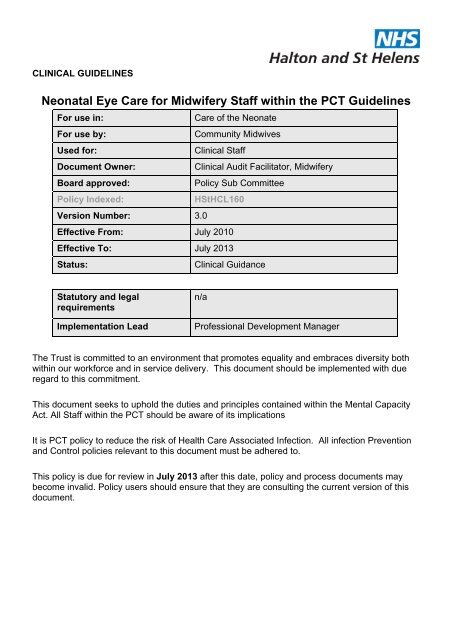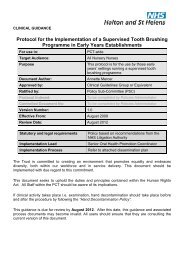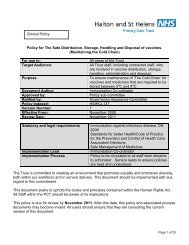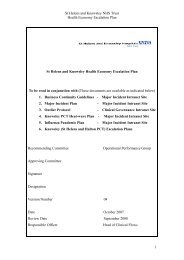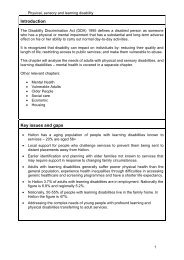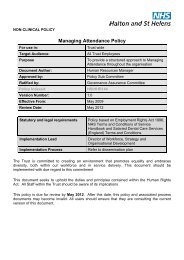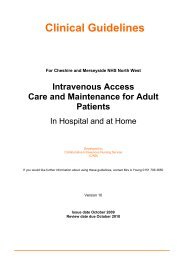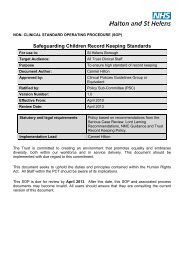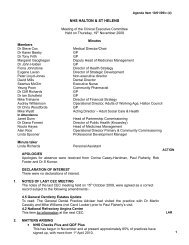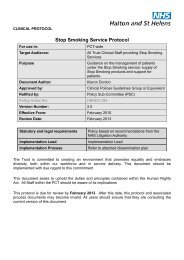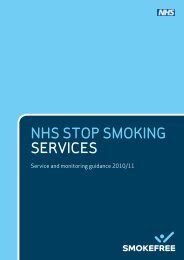Neonatal Eye Care for Midwifery Staff within the PCT Guidelines
Neonatal Eye Care for Midwifery Staff within the PCT Guidelines
Neonatal Eye Care for Midwifery Staff within the PCT Guidelines
You also want an ePaper? Increase the reach of your titles
YUMPU automatically turns print PDFs into web optimized ePapers that Google loves.
CLINICAL GUIDELINES<br />
<strong>Neonatal</strong> <strong>Eye</strong> <strong>Care</strong> <strong>for</strong> <strong>Midwifery</strong> <strong>Staff</strong> <strong>within</strong> <strong>the</strong> <strong>PCT</strong> <strong>Guidelines</strong><br />
For use in:<br />
<strong>Care</strong> of <strong>the</strong> Neonate<br />
For use by:<br />
Community Midwives<br />
Used <strong>for</strong>:<br />
Clinical <strong>Staff</strong><br />
Document Owner:<br />
Clinical Audit Facilitator, <strong>Midwifery</strong><br />
Board approved:<br />
Policy Sub Committee<br />
Policy Indexed:<br />
HStHCL160<br />
Version Number: 3.0<br />
Effective From: July 2010<br />
Effective To: July 2013<br />
Status:<br />
Clinical Guidance<br />
Statutory and legal<br />
requirements<br />
Implementation Lead<br />
n/a<br />
Professional Development Manager<br />
The Trust is committed to an environment that promotes equality and embraces diversity both<br />
<strong>within</strong> our work<strong>for</strong>ce and in service delivery. This document should be implemented with due<br />
regard to this commitment.<br />
This document seeks to uphold <strong>the</strong> duties and principles contained <strong>within</strong> <strong>the</strong> Mental Capacity<br />
Act. All <strong>Staff</strong> <strong>within</strong> <strong>the</strong> <strong>PCT</strong> should be aware of its implications<br />
It is <strong>PCT</strong> policy to reduce <strong>the</strong> risk of Health <strong>Care</strong> Associated Infection. All infection Prevention<br />
and Control policies relevant to this document must be adhered to.<br />
This policy is due <strong>for</strong> review in July 2013 after this date, policy and process documents may<br />
become invalid. Policy users should ensure that <strong>the</strong>y are consulting <strong>the</strong> current version of this<br />
document.
Table of Contents<br />
Rationale......................................................................................................................................3<br />
Development................................................................................................................................3<br />
Background..................................................................................................................................3<br />
Clinical evidence of infection........................................................................................................4<br />
Alerts............................................................................................................................................4<br />
<strong>Guidelines</strong> <strong>for</strong> <strong>Neonatal</strong> <strong>Eye</strong> <strong>Care</strong>................................................................................................4<br />
References...................................................................................................................................7<br />
Appendix 1 ...................................................................................................................................8<br />
Equality Impact Assessment Tool .............................................................................................8<br />
Appendix 2 ...................................................................................................................................9<br />
Dissemination and Training Plan...............................................................................................9<br />
Appendix 3 ................................................................................... Error! Bookmark not defined.<br />
Checklist <strong>for</strong> Document Development ....................................... Error! Bookmark not defined.<br />
Page 2 of 9
RATIONALE<br />
To provide guidance on neonatal eye care in <strong>the</strong> absence of evidence via randomised<br />
controlled trials. To prevent <strong>the</strong> introduction of infection via unnecessary interventions. To aid<br />
identification of signs of eye infection be<strong>for</strong>e investigation and treatment. To ensure<br />
investigation and treatment of appropriate cases.<br />
DEVELOPMENT<br />
Halton <strong>Midwifery</strong> Audit Group made up of representatives of each <strong>Midwifery</strong> Team, conducted<br />
literature searches and consulted local hospitals, paediatricians and microbiologists be<strong>for</strong>e<br />
producing <strong>the</strong> original guidelines in 2003. A literature search was carried out <strong>for</strong> <strong>the</strong> review in<br />
January 2008 (ATHENS, ebooks (MyLibrary), ejournals (Proquest), ADITUS, NHS National<br />
Library <strong>for</strong> Health, Ox<strong>for</strong>d Journals, etc.)<br />
BACKGROUND<br />
CONGENITAL LACRIMAL OBSTRUCTION (Blocked Tear Duct) (Young and MacEwen 1997)<br />
NB: Later literature cites <strong>the</strong> work of Young & MacEwen and adds nothing fur<strong>the</strong>r<br />
• Patency of <strong>the</strong> lower end of <strong>the</strong> nasolacrimal duct is not complete until birth.<br />
• A membranous obstruction may persist in up to 70% of neonates.<br />
• If this impatency persists it results in watering and discharge from <strong>the</strong> eye.<br />
• There is a high rate of spontaneous resolution with 70% of affected babies being free of<br />
symptoms by 3 months.<br />
• Can persist up to 12 months and <strong>the</strong>n needs referral <strong>for</strong> opthalmological assessment.<br />
• Characteristic presentation is persistent epiphora (watering) and mucopurulent<br />
(white/creamy) discharge usually affecting only one eye although both eyes may be<br />
affected in up to 20% of cases.<br />
• The affected eye usually has a white conjunctiva with no evidence of infection.<br />
• Crusting on <strong>the</strong> lid margin is common and parents may report <strong>the</strong> eyelids being stuck<br />
toge<strong>the</strong>r.<br />
• Presents <strong>within</strong> <strong>the</strong> first few days after delivery.<br />
Page 3 of 9
• There is NO EVIDENCE to support <strong>the</strong> use of antibiotics and <strong>the</strong>se should only be used<br />
when <strong>the</strong>re is clinical evidence of infection.<br />
CLINICAL EVIDENCE OF INFECTION<br />
• Conjunctivitis - characterised by redness of <strong>the</strong> white of <strong>the</strong> eye.<br />
• New swelling of <strong>the</strong> affected eyelid(s) - not connected to birth trauma.<br />
• Purulent discharge - characterised by yellow/green colour.<br />
• Changes to <strong>the</strong> lining of <strong>the</strong> lower lid - a plushy, hyperaemic appearance is typical of<br />
chlamydia infection (Young J and MacEwen CJ 1997) which is more persistent and does<br />
not respond to usual treatment. (Johnston 1998).<br />
ALERTS<br />
• Severe purulent discharge (especially at Day 1 or 2 postpartum) requires a normal swab<br />
to be taken. Request urgent Gram Stains on specimens on accompanying microbiology<br />
request <strong>for</strong>m, to exclude Gonococcal infection (Thureen et al 1999).<br />
• If suspicious of herpes, discuss specimen with Public Health Laboratory and General<br />
Practitioner (G.P.).<br />
• If suspicious of chlamydia, specialised swabs should be taken by a qualified practitioner<br />
after removing discharge from <strong>the</strong> eyes using sterile saline. (Chlamydia are intracellular<br />
pathogens and pus is a very poor quality specimen).<br />
GUIDELINES FOR NEONATAL EYE CARE<br />
ACTION<br />
RATIONALE<br />
1 In all cases<br />
1<br />
<br />
Explain all procedures to parents<br />
<br />
To obtain in<strong>for</strong>med consent<br />
<br />
Document procedures as appropriate<br />
<br />
To fulfill record keeping requirements<br />
as per Nursing & <strong>Midwifery</strong> Council<br />
2005<br />
<br />
Thorough hand washing be<strong>for</strong>e and<br />
after any procedure as per Infection<br />
Control Team policy<br />
<br />
To prevent <strong>the</strong> introduction of<br />
infection<br />
<br />
Equipment <strong>for</strong> procedures: clean<br />
container; cool, boiled water; cotton<br />
Page 4 of 9
wool<br />
2 Routine<br />
2<br />
<br />
At delivery: if <strong>the</strong>re is an indication to<br />
do so wipe <strong>the</strong> eye area, with a dry<br />
sterile swab, by wiping from <strong>the</strong> inner<br />
aspect to <strong>the</strong> outer aspect of <strong>the</strong> eye<br />
using one swab once only<br />
<br />
To prevent <strong>the</strong> introduction of<br />
infection<br />
<br />
<br />
At bathing: <strong>the</strong> eyes do not need to be<br />
routinely washed (Sweet B 1999)<br />
Advice to parents:<br />
Thorough handwashing and<br />
general hygiene<br />
<br />
To prevent <strong>the</strong> introduction of<br />
infection<br />
<br />
<br />
To report any discharge from<br />
baby's eye to midwife<br />
Of <strong>the</strong> high incidence of blocked<br />
tear duct (70%) "incidence so high<br />
and resolution so common that it<br />
could be regarded as <strong>within</strong> <strong>the</strong><br />
range of normal development"<br />
(Young J, MacEwen CJ 1997)<br />
<br />
<br />
<br />
To facilitate health promotion<br />
To reduce parental anxiety<br />
To enable parents to be fully<br />
in<strong>for</strong>med<br />
3<br />
Management of <strong>Neonatal</strong> <strong>Eye</strong><br />
Discharge<br />
3<br />
(a)<br />
Without signs of infection (see page 3)<br />
(a)<br />
<br />
<br />
Reassure parents<br />
Wash hands<br />
<br />
<br />
To reduce anxiety<br />
To prevent <strong>the</strong> introduction of<br />
infection<br />
<br />
To prevent/alleviate crusting<br />
<br />
<br />
<br />
Wipe away secretions, by wiping from<br />
<strong>the</strong> inner aspect to <strong>the</strong> outer aspect of<br />
<strong>the</strong> eye using one swab once only and<br />
using cool boiled water (Johnston<br />
1998)<br />
Dispose of clinical waste appropriately<br />
Be alert <strong>for</strong> signs of infections<br />
<br />
<br />
To prevent cross infection<br />
To facilitate early recognition of<br />
infection<br />
(b)<br />
With signs of infection (see page 3)<br />
(b)<br />
Page 5 of 9
Reassure parents<br />
<br />
To reduce anxiety<br />
<br />
Wash hands<br />
<br />
To prevent cross infection<br />
<br />
Take swabs separately from each eye<br />
and label containers appropriately<br />
<br />
To enable identification of results<br />
<br />
<br />
Transport in medium with completed<br />
documentation including any relevant<br />
maternal history of sexually transmitted<br />
disease/vaginal discharge<br />
If suspicious of chlamydia, see Alerts<br />
on page 3 of <strong>the</strong>se guidelines<br />
<br />
<br />
To enable culture and sensitivity<br />
tests at <strong>the</strong> laboratory<br />
To ensure appropriate specimen <strong>for</strong><br />
laboratory testing<br />
<br />
<br />
In<strong>for</strong>m GP of findings and<br />
investigations<br />
Advise parents to wipe away<br />
secretions by wiping from <strong>the</strong> inner<br />
aspect to <strong>the</strong> outer aspect of <strong>the</strong> eye<br />
using one swab once only and using<br />
cool boiled water (Johnston 1998)<br />
<br />
<br />
To facilitate good communication &<br />
liaison and commence treatment if<br />
required by GP<br />
To prevent/alleviate crusting.<br />
4 If Treatment Required<br />
4<br />
If treating while awaiting results,<br />
ensure preparations are used which<br />
will not interfere with chlamydia<br />
cultures if taken subsequently (Allen<br />
2001)<br />
As determined by swab results and<br />
prescribed by G.P.<br />
Refer back to G.P. if no improvement<br />
following treatment<br />
<br />
<br />
<br />
To avoid interference if chlamydia<br />
swabs subsequently required<br />
To ensure appropriate treatment<br />
To facilitate fur<strong>the</strong>r investigations<br />
Page 6 of 9
REFERENCES<br />
Reference<br />
ALLEN K (2001) Correspondence from Consultant<br />
Microbiologist, St Helens & Knowsley Hospitals Trust<br />
Relevance<br />
(whole<br />
document or<br />
section,<br />
please state)<br />
Evidence<br />
Grade<br />
JOHNSTON PGB (1998) The Newborn Child Churchill<br />
Livingstone. USA and London<br />
NURSING & MIDWIFERY COUNCIL (2004) Code of<br />
Professional Conduct NMC London<br />
NURSING & MIDWIFERY COUNCIL (2005) <strong>Guidelines</strong> <strong>for</strong><br />
Records & Record keeping NMC London<br />
SWEET B (1999) Maye’s <strong>Midwifery</strong> (Ed.) Harcourt, London<br />
THUREEN PJ, DEACON J, O'NEILL P, HERNANDEZ J<br />
(1999) Assessment and <strong>Care</strong> of <strong>the</strong> Well Newborn<br />
Saunders. USA<br />
YOUNG JOH, MacEWEN CJ (1997) Managing Congenital<br />
Lacrimal Obstruction in General Practice. British Medical<br />
Journal Vol. 315 2 nd August 1997 pp293-296<br />
Halton & St Helens <strong>PCT</strong> Policies:<br />
Consent to Examination or Treatment Policy (Oct 2007)<br />
Record Keeping Policy (Jan 2008)<br />
Infection Control Policy No 2 – Handwashing (Jan 2007)<br />
Infection Control Policy No 1 – Universal Precautions (Jan<br />
2007)<br />
Page 7 of 9
APPENDIX 1<br />
Equality Impact Assessment Tool<br />
To be completed with <strong>the</strong> corporate document when submitted to <strong>the</strong> appropriate committee <strong>for</strong><br />
consideration, approval and ratification.<br />
1. Does <strong>the</strong> corporate document affect one group<br />
less or more favourably than ano<strong>the</strong>r on <strong>the</strong> basis<br />
of:<br />
Yes/No<br />
Race No<br />
Ethnic origins (including gypsies and travellers) No<br />
Nationality No<br />
Comments<br />
Gender Yes Women only<br />
Culture No<br />
Religion or belief No<br />
<br />
Sexual orientation including lesbian, gay and<br />
bisexual people<br />
Age No<br />
<br />
Disability - learning disabilities, physical disability,<br />
sensory impairment and mental health problems<br />
2. Is <strong>the</strong>re any evidence that some groups are<br />
affected differently?<br />
3. If you have identified potential discrimination, are<br />
<strong>the</strong>re any exceptions valid, legal and/or<br />
justifiable?<br />
4. Is <strong>the</strong> impact of <strong>the</strong> policy/guidance likely to be<br />
negative?<br />
No<br />
No<br />
No<br />
Yes<br />
5. If so can <strong>the</strong> impact be avoided? N/A<br />
6. What alternative are <strong>the</strong>re to achieving <strong>the</strong><br />
policy/guidance without <strong>the</strong> impact?<br />
7. Can we reduce <strong>the</strong> impact by taking different<br />
action?<br />
If you have identified a potential discriminatory impact of this corporate document, please refer it<br />
to [insert name of appropriate person], toge<strong>the</strong>r with any suggestions as to <strong>the</strong> action required<br />
to avoid/reduce this impact. For advice in respect of answering <strong>the</strong> above questions, please<br />
contact [insert name of appropriate person and contact details].<br />
No<br />
N/A<br />
No<br />
Page 8 of 9
APPENDIX 2<br />
Dissemination and Training Plan<br />
To be completed with <strong>the</strong> corporate document when submitted to <strong>the</strong> appropriate committee <strong>for</strong><br />
consideration, approval and ratification. The status column must be given a Red, Amber or<br />
Green rating with evidence to demonstrate an action has been completed.<br />
DISSEMINATION PLAN<br />
Title of document: <strong>Neonatal</strong> eye care <strong>for</strong><br />
<strong>Midwifery</strong> staff<br />
Dissemination Lead: (Print name and<br />
contact details)<br />
Angela O’Neill<br />
0151 495 5054<br />
Angela.oneill@hsthpct.nhs.uk<br />
Proposed action to retrieve out-of-date<br />
copies of <strong>the</strong> document: In<strong>for</strong>m team<br />
leaders to remove and replace with<br />
current document.<br />
Date finalised: June 2010<br />
Previous document already being used? Yes<br />
If yes, in what <strong>for</strong>mat and where? Electronic/Intranet. Hard<br />
copies with team leaders.<br />
Withdraw from <strong>the</strong> internet/intranet/portal<br />
To be disseminated to: All Halton<br />
Midwives<br />
Disseminated<br />
by whom?<br />
Timescale<br />
(Date)<br />
Status<br />
R A G<br />
Paper<br />
or<br />
Electronic<br />
Comments<br />
Trust Times<br />
Team Brief<br />
Training sessions (Give Details Below)<br />
O<strong>the</strong>r (Give Details Below)<br />
Team leaders July 2010 Red Both<br />
Training Timescale Owner Status<br />
R A G<br />
Training Event (Please provide details of available training venues/dates to<br />
educate staff about this document)<br />
Training Plan Lead (Please provide details of staff who will be responsible<br />
<strong>for</strong> overseeing this training)<br />
Compliance Monitoring:<br />
Midwives practice is monitored annually by <strong>the</strong> supervisor of midwives and<br />
daily by <strong>the</strong>ir peers.<br />
Timescale Owner Status<br />
R A G<br />
<br />
<br />
Methodology to be used <strong>for</strong> monitoring/audit (please include <strong>PCT</strong><br />
Audit Proposal Form)<br />
Responsibilities <strong>for</strong> conducting monitoring/audit<br />
Frequency of monitoring/audit (e.g. annually, 6 monthly etc) Annually Red<br />
Process <strong>for</strong> reviewing/reporting results Ongoing Amber<br />
Denotes: Action not yet taken or deadline <strong>for</strong> action not met. Action plan to address this must be provided.<br />
Denotes: Action partially implemented.<br />
Denotes: Action complete.<br />
Page 9 of 9


